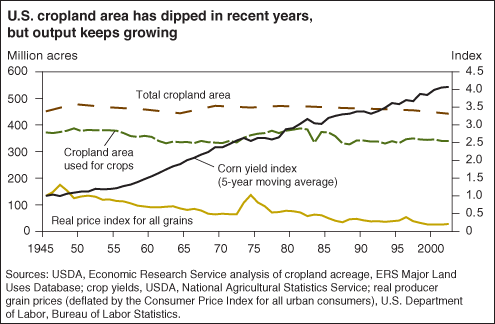Growing More With Less Cropland
- by Ruben N. Lubowski
- 6/1/2006
Despite long-term declines in crop prices and widespread concerns over urban encroachment on farmlands, cropland area has dipped only slightly since the 1940s while technological advances have boosted agricultural output. Between 1997 and 2002, U.S. total cropland area declined about 3 percent to 442 million acres, the lowest level since USDA began compiling this statistic in 1945. Although this decline marks a milestone in terms of land use, it does not mean a reduction in agricultural production. In fact, the opposite is true: Increasing productivity is allowing U.S. farmers to produce more crops with less land.
The value of U.S. crop output in 2002, measured in real (inflation-adjusted) terms, was 2.6 times higher than in 1948, although the value of aggregate input use declined over this period. Thus, farmers are extracting more output—and greater dollar value—out of fewer resources. Greater use of nonland capital and materials like energy and agricultural chemicals has substituted for land and labor. Increases in yields, due to improved seeds and other technological changes, have also raised output. From 1945 to 2002, average corn yields quadrupled while real prices received for grains fell by 80 percent. As a result of rising productivity, despite a smaller land area devoted to crops, U.S. agricultural output continues to grow and consumers continue to pay lower real prices.
Total cropland includes land planted for crops, land used for pasture as part of a crop rotation, and cropland idled under government programs, such as USDA’s Conservation Reserve Program, which pays farmers to voluntarily retire environmentally sensitive cropland under 10- to 15-year contracts. Since World War II, total cropland area has ranged between 442 and 478 million acres and only decreased by 9 million acres (2 percent) between 1945 and 2002. The decline in total cropland from 1945 was due to a 23-million-acre (6 percent) reduction in the area planted for crops, which was offset by an increase in cropland pasture. Cropland used for crops peaked at 387 million acres in 1949, reached a 57-year low of 327 million acres in 1988, and has since held steady at around 340 million acres.
The long-term changes in national cropland acreage mask greater land-use redistribution occurring at regional and State levels. From 1945 to 2002, total cropland in the Southeast, Northeast, Appalachia, Lakes States, Delta States, and Far West declined by about 37 million acres (24 percent), but increased by 28 million acres (10 percent) in the remaining regions. This further concentrated acreage of cropland in the major crop-producing regions.
This article is drawn from:
- Major Land Uses. (n.d.). U.S. Department of Agriculture, Economic Research Service.
- Agricultural Productivity in the United States. (n.d.). U.S. Department of Agriculture, Economic Research Service.
- Lubowski, R.N., Vesterby, M., Bucholtz, S., Baez, A. & Roberts, M. (2006). Major Uses of Land in the United States, 2002. U.S. Department of Agriculture, Economic Research Service. EIB-14.


